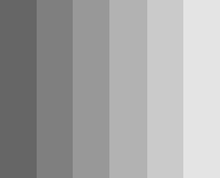
Back Bandes de Mach Catalan Machovy proužky Czech Machsche Streifen German Bandas de Mach Spanish باندهای ماخ Persian Bandes de Mach French Mach-sávok Hungarian Effetto Mach Italian マッハバンド Japanese Pasmo Macha Polish


Mach bands is an optical illusion named after the physicist Ernst Mach. It exaggerates the contrast between edges of the slightly differing shades of gray, as soon as they contact one another, by triggering edge-detection in the human visual system. The Mach band illusion is sometimes called the Chevreul illusion.[1]
- ^ Geier, János; Hudák, Mariann (2011-10-13). "Changing the Chevreul Illusion by a Background Luminance Ramp: Lateral Inhibition Fails at Its Traditional Stronghold - A Psychophysical Refutation". PLoS One. 6 (10): e26062. doi:10.1371/journal.pone.0026062. ISSN 1932-6203. PMC 3192777. PMID 22022508.